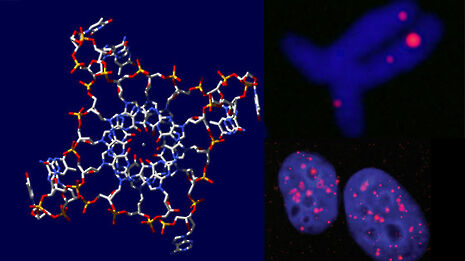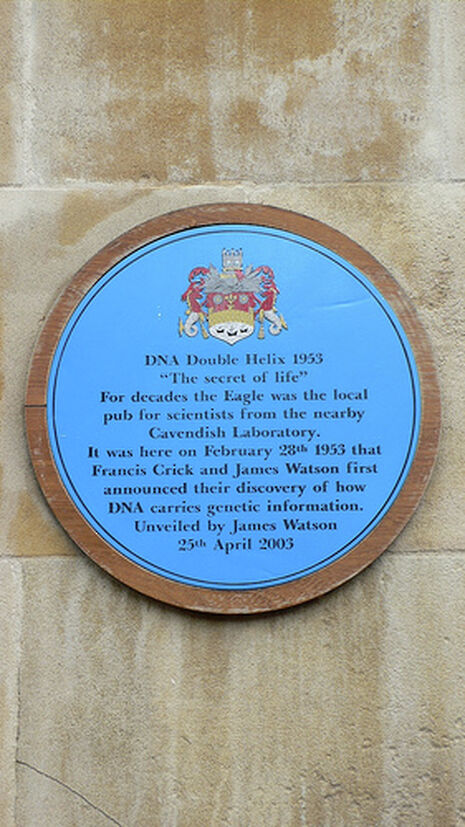Cambridge scientists discover quadruple-helix DNA in human cells
Researchers publish paper confirming the presence of four-stranded DNA in human cells

Sixty years after Francis Crick and James Watson famously declared that they had discovered the double- helix structure of DNA, a new generation of Cambridge scientists have published a paper confirming the presence of four- stranded “quadruple helix” DNA in human cells, a discovery which they claim may lead to the development of new drugs to fight cancer.
The paper, published in the Nature Chemistry journal, proves the existence of the quadruple-helix DNA structures, known as G-quadruplexes, in regions of DNA rich in guanine, one of the four building-blocks of genetic code. While previous studies had shown that these structures could form in vitro (“in the test- tube”) they weren’t believed to occur naturally in human cells.
In order to detect the G-quadruplexes, Giulia Biffi, a member of the research team that carried out the study, made antibody proteins that bound to the structures. Using fluorescent markers, they were able to observe the areas in the genome where these structures were concentrated and, crucially, at what stage of the cell cycle.
According to the findings, the occurrence of G-quadruplexes increases during a phase of the cell cycle known as the 's' phase, when DNA replication takes place. This behaviour is of key interest in the studies of cancers, which occur when mutated genes known as oncogenes cause DNA replication and cell division to increase uncontrollably.
The fact that quadruple-helix DNA structures are more likely to occur in rapidly dividing cells such as cancer cells means they could potentially play a role in whether or not a cell becomes cancerous. If this is the case, their discovery will pave the way for the development of new cancer treatments that specifically target the G-quadruplexes in cancerous cells without harming healthy ones.
“We are seeing links between trapping the G-quadruplexes with molecules and the ability to stop cells dividing, which is hugely exciting,” says Professor Shankar Balasubramanian of the Universityof Cambridge’s Department of Chemistry and the Cambridge Research Institute.
While many current cancer treatments attack DNA, it is not quite clear where in the genome they react, leading to what Balasubramanian refers to as a “scattergun approach”.
“The research indicates that G-quadruplexes are more likely to occur in genes of cells that are rapidly dividing, such as cancer cells” explains Balasubramanian, “for us, it strongly supports a new paradigm to be investigated – using these four-stranded structures as targets for personalised treatments in the future.”
It is hoped that pharmaceutical companies will now use the latest research to develop cancer treatments. Dr Julie Sharp, senior science information manager at Cancer ResearchUKwho funded the research, says: “This research further highlights the potential for exploiting these unusual DNA structures to beat cancer – the next part of this pipeline is to figure out how to target them in tumour cells.”
“It’s been sixty years since its structure was solved but work like this shows us that the story of DNA continues to twist and turn.”
-------------------------------------------------------------------------------------------------
The history of DNA in Cambridge
Phelim Brady

In 1953 when young researchers James Watson and Bernard Crick walked in to the Eagle pub on Bene’t Street in Cambridge to announce they had discovered the structure of human DNA, little did they know that 60 years later researchers in the very same city would announce the discovery of a ‘quadruple helix’, proved to be present in human cells for the first time. Crick, at 37, and Watson, an American from Chicago at only 25, were subsequently awarded the 1962 Nobel Prize for physiology or medicine.
While work on DNA had already been conducted elsewhere, famously by former Newnham College student Rosalind Franklin, a researcher at King’s College London, but the announcement in the 346 year old pub marked the first confirmation of the double helix structure.
A sculpture in the shape of a double helix was installed in the grounds of Clare College, Watson’s college, to commemorate the discovery in 2005, and today a plaque stands outside the Eagle telling passersby of the discovery. Varsity was the first newspaper in the world to report the discovery, running an article on the subject in May 1953.
 Features / How sweet is the en-suite deal?13 January 2026
Features / How sweet is the en-suite deal?13 January 2026 Comment / Will the town and gown divide ever truly be resolved?12 January 2026
Comment / Will the town and gown divide ever truly be resolved?12 January 2026 News / 20 vet organisations sign letter backing Cam vet course13 January 2026
News / 20 vet organisations sign letter backing Cam vet course13 January 2026 Arts / Fact-checking R.F. Kuang’s Katabasis13 January 2026
Arts / Fact-checking R.F. Kuang’s Katabasis13 January 2026 Music / Inside Radiohead’s circle13 January 2026
Music / Inside Radiohead’s circle13 January 2026









